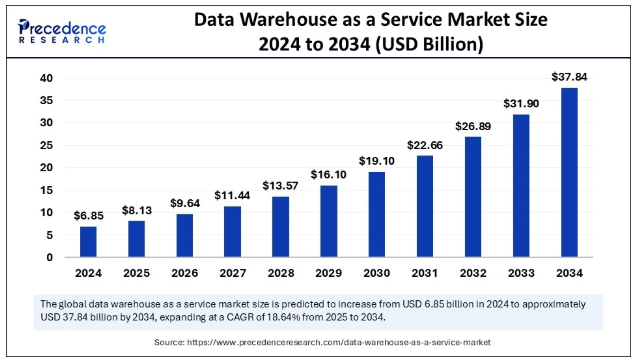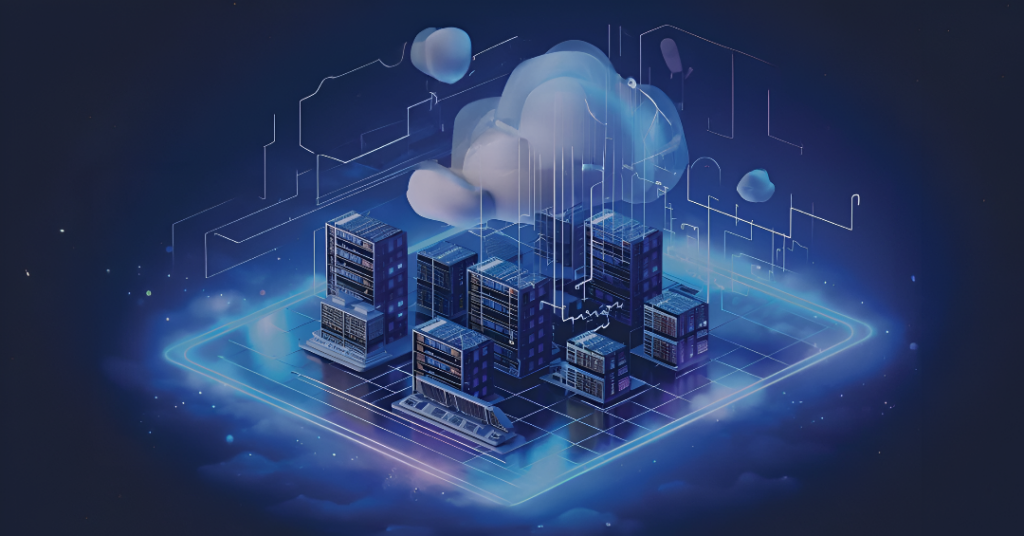Data Warehouse Modernization: Businesses have become increasingly data-driven. The more data you have the more you are likely to lose in case of data leak or system outages. Due to poorly managed data, business operations can slow down, uncorrected expenditures can be raised, and insights can be limited.
By leveraging Data Warehouse Modernization, it solves these problems by replacing old data systems with new, faster, and smarter technologies. often delivered through cloud platforms, automation, and advanced analytics tools.
Your database can be modernized not only for speed, but it also involves making the data easier to access, encrypting it, and preparing it for real-time decision-making. This guide is written for those who are obsessed with sluggishness, maintenance expenses, or the necessity of AI-powered analytics support; every issue you might be experiencing is solved here in this guide.
As per The Business Research Company, data warehousing modernization proposes that the growth rate is changing in such a positive way that the market volume will grow from 33.76 billion USD in 2024 to as much as 69.64 billion USD in 2029. This indicates a CAGR (Compound Annual Growth Rate) of 16.6%. Additionally, the Data Warehouse as a Service (DWaaS) segment is predicted to outgrow the other three segments.
According to Precedence Research, data warehouse modernization should have increased by a CAGR of 18.64% from an existing 8.13 billion USD industry in 2025 to a 37.84 billion USD industry in 2034. This growth is due to the fact that more and more businesses are demanding data management solutions that are cloud-based and scalable. The former feature helps reduce costs, while the latter helps manage data storage comprehensively.

This article covers various aspects of Data Warehouse Modernization, such as its definition, implementation strategies, benefits of data warehouse modernization, and real-world data warehouse modernization use cases. If you aim to grow performance, use AI in your technology, or ensure that your data infrastructure perfectly fits in your business, this final reference will offer you the necessary understanding of how to master the journey of modernization successfully.
Table of Contents
What is Data Warehouse Modernization?
Data Warehouse Modernization is a term used to describe the concept of modifying and reconstructing old data warehouse systems to a level compatible with what enterprises that rely on data are expecting. It is the process of shifting from the outdated and non-flexible on-premise platforms to those that are more dynamic, scalable, and inclusive of the cloud. Data warehouses are required for real-time analytics, advanced data integration, and future-ready technologies.

Definition and Scope
The main factor of data warehouse modernization is an enhancement in the storage, processing, and analysis of the company’s data. This step is not limited to the technological part alone; it is also a strategic data modernization step to enable the data to be available to more people, easier to manipulate, and ultimately, to be delivered in a more usable condition for decision-making. The general concept revolves around the company’s better performance, cost cuts, and flexibility directional changes, with modern analytics tools being offered as well.
Key Components Involved
Modernization typically involves several components:
- Migration: This is the process of transferring workloads and data from on-premise systems to cloud or hybrid environments. The move is made for greater flexibility and reduced infrastructure management.
- Automation: The steps to modernize data warehouse, transformation (ETL/ELT), and quality checks are the ones that can be executed automatically through the use of robots prepared especially to carry out the process more efficiently and with utmost accuracy.
- Integration: Various systems such as CRMs, ERPs, cloud apps, and data lakes must be connected with the data warehouses in order to build a coherent data ecosystem, which makes this the most important aspect of the process.

Difference Between Traditional and Modern Data Warehousing
As businesses generate more data from various sources, it’s important to adopt a data warehouse that can handle modern requirements. Traditional data warehousing systems, while once effective, often struggle to keep up with the current speed, scale, and integration demands.
Here’s how modern data warehousing compares across key aspects:
| Aspect | Traditional Data Warehouse | Modern Data Warehouse |
| Infrastructure | On-premise hardware | Cloud-native or hybrid |
| Scalability | Limited and expensive to scale | Easily scalable on demand |
| Performance | Slower, especially with large data volumes | High-speed processing and real-time capabilities |
| Data Types Supported | Mostly structured data | Structured, semi-structured, and unstructured data |
| Integration | Limited and manual | Seamless integration with cloud apps, APIs, and data lakes |
| Maintenance | Requires manual upkeep and IT staff | Automated updates and low maintenance |
| Cost Structure | High upfront and ongoing costs | Pay-as-you-go or subscription-based |
| Analytics Support | Batch reporting and historical analysis | Real-time analytics, AI, and machine learning support |
| Flexibility | Rigid and difficult to modify | Agile, configurable, and responsive to changing needs |
| Deployment Speed | Weeks or months | Days or hours with cloud services |
| Security & Compliance | Basic security features | Advanced cloud security, encryption, and compliance tools |
Why Data Warehouse Modernization is a Must in the Digital Era?

In today’s growing digital world, businesses rely on data more than ever. However, inefficient data systems that are out of date are the common hurdles faced by innovative, fast, and smart decision-making processes. That’s the reason that data warehouse modernization is a necessity now, not an option.
Challenges of Legacy Data Warehouses
Old data warehouses were not built with the needs of fast and high-throughput data of today in mind.
- Scalability Limitations: Legacy systems cannot follow the growth of your data, creating storage and performance issues.
- Performance Bottlenecks: Slow processing and delayed queries decrease productivity and hamper business insights.
- High Maintenance Costs: The costs of traditional infrastructures are high because of the need for expensive hardware and constant maintenance.
- Poor Integration with Modern Tools: Old systems are not interoperable with cloud apps, BI tools, or machine learning platforms, which results in complicated modern analytics.
Compelling Reasons to Modernize
Confronting these issues head-on and effectively extracting the full value of a data system are the ways in which modern data warehouses tackle these challenges.
- Increased Agility and Performance: New platforms are making speedier data access, more profound insights, and faster decision-making processes possible.
- Cloud-Readiness: Cloud-based data warehouses are the way forward as they are cost-effective, highly scalable, and flexible.
- Competitive Advantage: Acting first, giving your customers the best, and coming up with new ideas are what new modern data-clocked companies can do better.
- Support for Real-Time Analytics and AI: Tools like real-time dashboards, predictive analytics, and AI needs to be integrated where time is of the essence
Key Drivers of Data Warehouse Modernization
Several forces are pushing companies toward modernization:
Business Drivers: Faster decision-making, the best customer journey, and maximum efficiency are the most important reasons.
Technological Drivers: Innovation in cloud computing, big data, AI, and analytics tools that can not be accessed if people are operating with legacy systems.
Strategic Drivers: Objectives related to digital transformation, strategies based on data, and the necessity of being one step ahead of others are the main reasons why companies are going through this process.
Key Benefits of Data Warehouse Modernization in 2025
Enabling data volumes and business demands to grow, and implementing data warehouse modernization promptly in 2025, can become a real competitive advantage for your business. Companies have the following benefits of data warehouse modernization:
1. Improved Speed and Performance
New data warehouses execute queries more quickly and can perfectly cope with bigger loads of work. This means faster insights, improved decision-making, and most importantly, satisfied users are in the pipe.
2. Cost Efficiency with Pay-as-You-Go Models
You only pay for the data storage and computational resources that you actually consume with the help of cloud platforms. Such a flexible model assists in cost control and prevents overspending on unnecessary infrastructure.
3. Enhanced Security and Compliance
New technologies are protected by default thanks to encryption, access control, and the availability of compliance instruments, which all ensure the data is safe and up to the mark with the GDPR or HIPAA regulations.
4. AI & Advanced Analytics Readiness
The latest warehouses are much more than just being AI-compliant; they are also assisting in machine learning and predictive analytics, which in turn become the driving force in businesses to find deeper insights and to arrive at smart decisions.
5. Seamless Data Integration
Technological update is the only way to guarantee straightforward data flow from multiple sources like cloud applications, databases, IoT, and others, into one single access point for analysis.
6. Cloud-Native Scalability & Flexibility
All you need to do if your data center is cloud-native is to match the needs of your business with its ability to either increase or shrink the size without the physical or storage limit constraints.
7. Better BI and Visualization Integration
Modern systems are tightly integrated with BI tools such as Power BI and Tableau. In the same way, these tools help build visual dashboards and allow for the sharing of insights, making decision-making easier.
8. Automation and DevOps-Friendly Architecture
Today’s platforms assist you in utilizing DevOps tools and automation methods to ensure faster deployment, testing, and updates with minimal human intervention.
9. Global Accessibility & Collaboration
Warehouses based on cloud technology provide a secure collaborative supply chain from any location around the world with the use of the same datasets.
10. Future-Proofing IT Infrastructure
The process of modernization at a quicker pace makes sure that your systems are built with state-of-the-art technology, therefore wiping off technical debt and getting your business ready for new innovative developments.

Most Effective Methods for Data Warehouse Modernization
There are a number of proven methods that companies can use to update their data warehouse modernization in the most effective way. Which approach to take depends on your current situation, objectives, and resources.
Here are some of the most popular methods that are in use at present:
1. Data Warehouse Automation
The automation tools quickly do the repetitive tasks of data mapping, transformation, and loading. This way is more cost-effective at the time of the modernization process, with fewer manual errors, faster, and reliable at the same time. Hence, this method reinforces long-term automation success by reducing errors, saving time, and ensuring the modernization project’s progress.
2. Migration of On-Premise Systems to the Cloud
Changing from on-premise servers to cloud platforms (e.g., AWS, Azure, or Google Cloud) involves the benefit of scalability, less maintenance, and real-time data access. Thanks to the transition, companies can conveniently and promptly modernize their infrastructure while minimizing the risk of error and without the need for continuous onsite presence.
3. Use of Operational Data Warehouses
An Operational Data Warehouse (ODW) fosters real-time updating of data and facilitates quick decision-making. This quite useful approach is suitable for business firms that require pace-making insights to be available all the time, like those that operate in retail, logistics, and finance.
4. Integration with Data Lakes
Merging the warehouse with a data lake is a way to store the two types, structured and unstructured, of data together. Besides, this method extends the company’s analytics capabilities and supports advanced data warehouse modernization use cases in AI, Machine Learning, and big data analytics.
5. Extension of Existing Architecture’
By continuing your existing system and just modernizing in phases instead of a complete replacement, you may store your existing architecture. This is the least destructive way for businesses, which want the changes to be easy and gradual, without making everything all over at once.
6. Greenfield (From-Scratch) Development
A greenfield strategy refers to setting up a new data warehouse starting from a clean state and using new tools and strategies. It is the most suitable alternative for organizations that have no way of improving or fixing their systems, or are beginning with the modern cloud-native architecture.
How to Implement Data Warehouse Modernization?
To modernize a Data Warehouse, it is necessary to follow a few steps one after another to make sure the transition from the outdated systems is smooth and the new environment is high-performing and future-ready. The following is how it can be done in an effective way:
1. Assess Your Current Environment and Gaps
Begin by assessing your current data warehouse configuration. Pinpoint any performance problems, safety risks, and data processing constraints. This inspection is indispensable for recognizing the weak points and the gaps that need to be filled.
2. Select Appropriate Technology Platforms
You can choose from those modern platforms, such as Snowflake, Google BigQuery, or Amazon Redshift, that suit your data size, performance requirements, and budget. These platforms offer several advantages, such as scalability, speed, and a SAS-free environment.
3. Plan for Seamless Data Integration
Check if your new system can easily be linked to the existing tools and data sources (like CRM, ERP, API). A good integration will get rid of the data silos and offer a unified view of all business data.
4. Build Modern ETL/ELT Pipelines
Carry out the actions of moving and preparing data efficiently by means of automated ETL (Extract, Transform, Load) processes or ELT. The modern pipelines can also manage real-time data and reduce manual work, thereby speeding up the delivery of analysis.
5. Establish Data Quality Management Frameworks
The data quality is a key point. Let the facilities, as well as the rules and tools, set out principles for the detection and correction of errors, the data deduplication, and the accuracy verification. Pure and coherent data will lead to better business decisions.
6. Create Scalable Data Models
Establish your data structure in a way that will enable it to evolve in line with the growth of your company. Scalable designs allow you to introduce new data sources, users, and reports without doing any major restructuring.
7. Implement Cost Control and Resource Management
Most modern platforms charge based on the volume of usage. Implementing cost control, setting up staff to carry out regular checks, and finally implementing the budget is a way to not only control your costs but also manage to remain efficient so as to ensure implementation of modernization that stays efficient and affordable.
10 Real-World Data Warehouse Modernization Use Cases
More than just updating the technologies of your data warehouse, modernization refers to resolving real business problems and uncovering new and powerful opportunities. There are 10 data warehouse modernization use cases where Data creates real value:
1. Handling Large-Scale, High-Velocity Data
State-of-the-art data warehouses can process large amounts of data coming in from applications, IoT devices, and user interactions uninterruptedly and efficiently. This would help companies become agile even when the data grows further.
2. Enabling New-Gen Analytics Like Predictive Modeling
Using up-to-date platforms, companies can apply AI and machine learning tools to the data for such purposes as trend forecasting, pattern detection, and decision-making through predictive analytics.
3. Supporting Real-Time Dashboards and Alerts
The modern system allows the quick processing of real-time data, enabling businesses to run live dashboards and alerts for instant insights and early responses to changes in the market.
4. Replacing Aging Infrastructure
Out-of-date systems often result in delayed operations. Through the process of modernization, there is a possibility of swapping old technology with fast, reliable, and cost-effective cloud-based solutions.
5. Reducing Business Risk
A contemporary data warehouse is good not only for improved operations but also for preventing the loss of data and downtime, and ensuring compliance issues are addressed by tightening data quality, creating backups, and employing solid security practices.
6. Facilitating Data Democratization
Modernizing the data would enable not only the IT department but also other departments, such as the marketing team, to access trustworthy, real-time data directly so that everyone can make decisions without hovering over the IT team.
7. Breaking Down Data Silos
Modern platforms integrate footprinting data from various sources (CRM, ERP, etc.) onto a single platform, thus tearing down silos and creating a single version of truth.
8. Meeting Evolving Regulatory Requirements
When privacy laws and data regulations get altered, new platforms are a safer bet for more effective governance and compliance instruments, which in turn help organizations stay ahead of the game.
9. Mitigating Cybersecurity Risks
With better encryption, doorkeeper settings, and live tracking, modern data warehouses are able to defend against threats and data breaches in a more secure way.
10. Aligning Data Systems with Strategic Business Goals
The refurbishment of your data systems affects their capacity to serve what you see as your long-term business targets, such as customer personalization, expansion, or innovation.
Data Warehouse Modernization Roadmap
Planning to modernize your data warehouse is not only about a new infrastructure but also a complete end-to-end process that should provide better results and satisfaction to all concerned.
The urge to modernize your data warehouse could be driven by various reasons, ranging from the need to speed up the performance to the desire to carry out real-time analysis or even the need to cut costs. Regardless of the cause, the modernization process, if well defined and executed, will bring about more benefits than risks from the journey. The following is a simple guide to the roadmap of modernizing your data warehouse:
1. Discovery
The initial step involves analyzing your current data warehouse environment. You will discover the functioning and inefficiencies there, and you will know better now what systems or processes require improvement to achieve the goals of the company.
2. Goal Definition
Define such goals of the digital transformation as quicker reporting, better scalability, or preparation for Artificial Intelligence. These goals will help with technology adoption and project management.
3. Migration Planning
Think of the way to move data, workloads, and users to the new system. The choice of one-time and phased-out migrations, as well as the hybrid method, is related to the resources and risks of the project.
4. Design & Development
Create a new design and work with modern tools and platforms. Establish ETL/ELT pipelines, build data models, and ensure the design is powerful enough to support such future needs as analytics and automation.
5. Execution
Execute the migration of data, do system testing, and finally switch to the new system. Be quick to address any issues in performance. Also, organize training for users and make sure they are ready for the modernized environment.
Furthermore, the optimization after the execution is part of the process, which entails safeguards for monitoring, performance tuning, and user training.
The roadmap presented here is an enabler for a seamless transition to a modern data architecture. If an organization has the right plan and the right partner, such as A3Logics, they are able to, without a doubt, tap into the many benefits of data warehouse modernization, which include high agility, scalability, and actionable insights.
Why Modernize Your Data Warehouse with A3Logics?
Modernizing your database is not simply about staying with the most recent technology; it goes beyond that to discovering more profound insights, having better adaptability, and making wiser decisions in business.
At A3Logics, we have a comprehensive approach for data warehouse modernization, which requires the deconstruction and construction of the systems necessary for the future. This is how we have helped our customers to be the leaders of the modernization process:
1. Proven Expertise in Enterprise Data Transformation
A3Logics has been a cornerstone in the beginning of business data transformation, converting outdated systems into smart, efficient platforms for several years now. Their expert team really knows how to navigate through the complexity of the data environment and, at the same time, ensure the safe and efficient modernization of the systems.
2. End-to-End Modernization Services
Not only does A3Logics offer cloud migration post-deployment support planning, but it’s also among the companies that provide full, end-to-end data warehouse modernization services. Thus, the transition will be as smooth and business disruption as minimal as possible.
3. Custom Solutions with Latest Technologies
A3Logics is providing the most recent technologies, such as BigQuery and Snowflake, or in other words, if you only need a solution for a special case, and Azure Synapse to meet the data goals and technical requirements of the customer.
4. Reliable Support and Post-Migration Optimization
A3Logics proceeds with deployment, and they are in charge of all the ongoing activities like support, maintenance, and optimization to ensure that the newly established modern data warehouse performs steadily and without any deficiency in the delivery of the maximum value in a given period.

Conclusion
As we’ve seen together, data warehouse modernization has become one of those things that can no longer be “nice to have” but should become compulsory for companies looking to be prosperous in the data-driven cloud-first world. The outdated systems might lack the ability to grow, so they should be replaced with the new ones. As a result, with the advanced high-tech industry that generates the possibility of rapid deployment, modular flexibility, cutting operational costs, and future AI / real-time analytics applications.
Going through all stages of core value identification, goal setting, and proper implementation, you will fully exploit the benefits of data warehouse modernization and will enjoy benefits such as better performance, greater security, and strategic data modernization business growth. The new data management trend is to be lightweight, natively cloud-based, and ready for intelligence.
When your company is ready to advance, it is the right time to move ahead, and it will be nice to engage with us further. A3Logics provides you with its proven skills and a range of modernization services, and continuous support will be offered to you.
Please connect with the best A3Logics to start the journey of change in the company with the reliable partner of Data Warehouse Services and Data Analytics Services. Together, we can make your digital transformation an enjoyable and fast process.




